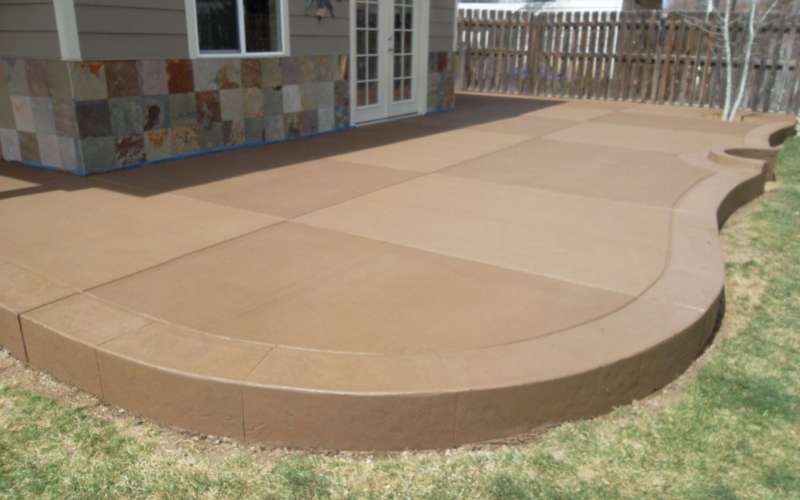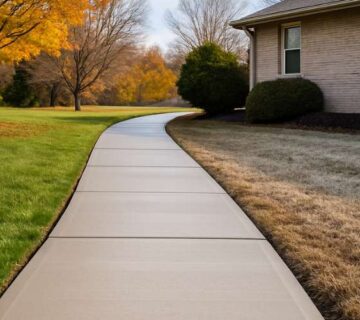Choosing the right concrete color is more than just picking your favorite shade. Concrete Color Options: How to Choose the Right Shade for Your Design Goals is a decision that influences the style, mood, and harmony of your space. Homeowners often feel overwhelmed by so many options, and one wrong choice can clash with the entire design. In this post, you’ll learn how to confidently select the best color to match your goals, your home’s exterior, and your personal taste.
Choosing the Best Concrete Color to Match Your Style and Design Goals
Concrete may seem like a blank canvas, but the color you choose can have a powerful visual impact. Whether you’re redoing your driveway, designing a patio, or adding a walkway, Concrete Color Options: How to Choose the Right Shade for Your Design Goals will help you make decisions that fit both your surroundings and your design vision. Your concrete isn’t just a foundation—it’s part of your overall look, and getting the shade right is key.
Start with Your Surroundings
The first step to choosing the right concrete color is to look closely at the area where the project will be installed. Your landscape, home exterior, roof color, and even the nearby vegetation influence how a concrete shade will appear. Earth tones often blend beautifully into natural settings, while grays and charcoals create striking contrasts for more modern styles. By paying attention to what already exists in your space, you can choose a concrete color that feels like it belongs, rather than one that competes for attention.
Match Color to Mood
Color affects emotion, so choosing a concrete shade should involve more than style—it should also support how you want the space to feel. Lighter tones like beige or tan bring a calm and inviting feel, perfect for patios or garden paths. If you prefer something bold and dramatic, darker tones like charcoal can add a strong modern edge. Cool gray shades offer a sleek, minimalistic vibe that suits contemporary homes. Your outdoor space should reflect your personality, and the color of your concrete plays a major role in achieving that.
Use Color Samples Before Committing
Even if you fall in love with a color on a screen or brochure, it’s important to test samples on-site before making a final decision. Concrete looks different depending on lighting, weather, and time of day. A soft gray might appear blue in shade or overly bright in direct sun. Moisture can also change how the surface looks temporarily. Placing test patches in your space allows you to see how a color performs in real conditions. This practical step helps avoid costly mistakes and ensures you’ll love the result.
Consider the Concrete Finish
The finish of the concrete is just as important as the color. A smooth finish tends to reflect more light, which can make the color appear deeper and glossier. On the other hand, a brushed or textured finish may soften the appearance, giving it a more natural or rustic look. If you’re using stamped concrete, multiple shades can be added to bring dimension and detail to the pattern. Always keep in mind that the same color can look very different based on the finish you choose, so this should be part of your overall color strategy.
Complement Your Design Features
Your concrete doesn’t exist in isolation—it connects with your home, landscaping, and other design elements. That’s why the color should enhance everything around it. For example, if your house features dark brown trim, a warm sandstone concrete tone could tie it all together. If you’re planning borders or inlays, using contrasting colors can highlight key areas and add depth. A well-thought-out color choice won’t just make the concrete look great—it will elevate the entire space by pulling together every detail in your outdoor design.
Think About Long-Term Appearance
It’s easy to focus on how a color looks today, but you should also think about how it will age over time. Sun exposure, rain, and foot traffic can all affect the color of concrete. Lighter shades are more prone to stains, while darker ones may absorb heat and feel warmer underfoot. Applying a high-quality sealant helps protect against fading and surface damage. When you plan for the future, you protect your investment and maintain the visual impact of your chosen color for many years.
Popular Color Choices and Their Impact
While personal taste plays a big role, some concrete colors have stood the test of time. Natural gray is a classic option for a reason—it’s versatile, neutral, and fits almost any space. Sandstone and beige create a welcoming tone and blend well with gardens or brick homes. Terracotta adds a rustic, Mediterranean flair, while dark charcoal suits urban or high-end designs. For a unique twist, slate blue can add personality without being overwhelming. When in doubt, review these popular choices and consider which one aligns best with your home’s overall style.
Don’t Forget Maintenance
Maintenance is a key part of the decision process. Even the most beautiful concrete can lose its charm without the right care. Darker shades may hide dirt, but they can also highlight water spots or chalking. Lighter shades show stains more quickly but feel cooler under sunlight. Glossy finishes often require more cleaning, while matte or textured finishes are more forgiving. No matter which color you choose, regular cleaning and sealing will keep your concrete looking vibrant. Choose a color that not only looks great but also suits your maintenance routine.
Ready to Transform Your Space with the Right Concrete Color?
Choosing the perfect shade doesn’t have to be stressful. With the right concrete color, your home can truly shine. Need help deciding? We’re here to guide you every step of the way. Contact our team today and let’s bring your vision to life!





No comment